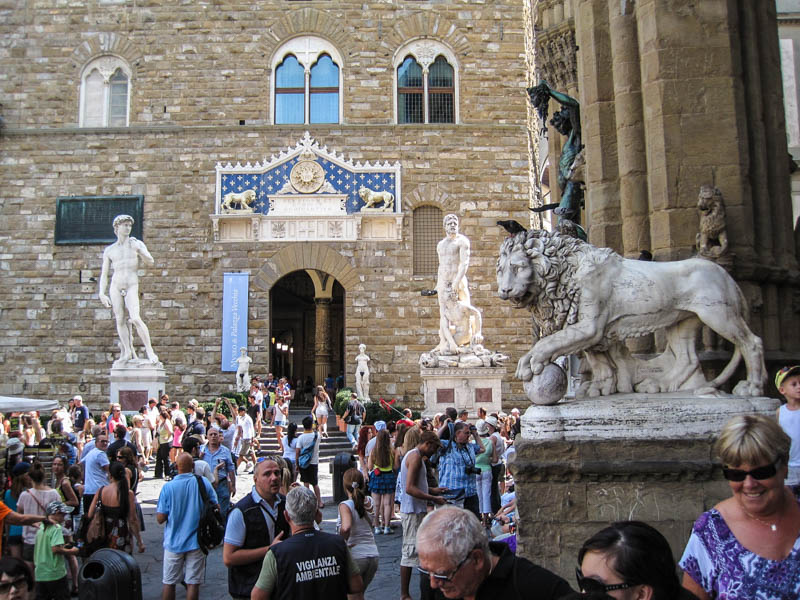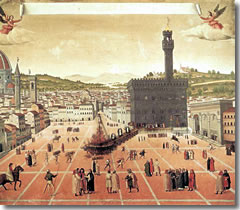

Piazza della Signoria, with the Palazzo Vecchio on the left and Loggia de' Lanzi on the right.In Italy, all roads lead to Rome, but in Florence all roads lead to the elegant Piazza della Signoria—the cultural, political, and social heart of the city since the 14th century, named after the oligarchic ruling body of the medieval city.
Today, it's an outdoor sculpture gallery, teeming with tourists, postcard stands, horses and buggies, and outdoor cafes and home to the fortress-like Palazzo Vecchio, off which stretches the "U" of the Uffizi Galleries, Florence's great art museum.
When the medieval Guelf party finally came out on top of the Ghibellines, they razed part of the old city center to build a new palace for civic government.
It's said the Guelfs ordered architect Arnolfo di Cambio to build what we now call the Palazzo Vecchio in the corner of this space, but to be careful that not one inch of the building sat on the cursed former Ghibelline land.
This odd legend was probably fabricated to explain Arnolfo's quirky off-center architecture.
On the south side of Piazza della Signoria—just to the right of the long U of the Uffizi—is the square's earliest and prettiest outdoor sculpture gallery, the 14th-century Loggia dei Lanzi (1376–82), named after the Swiss guard of lancers (lanzi) Cosimo de' Medici had stationed here.
The airy loggia was probably built on a design by Andrea Orcagna—spawning another of its many names, the Loggia di Orcagna (another is the Loggia della Signoria). The three huge arches of its simple, harmonious form were way ahead of the times, an architectural style that really belongs to the Renaissance.
The loggia has finally been freed of its scaffolding, and is open to visitors for the first time in decades. Benvenuto Cellini's rare 1545 masterpiece in bronze, Perseus, holding aloft Medusa's severed head, was returned here in 2000 after a four-year (and sorely needed) restoration.
On the far right of the loggia stands Giambologna's important Rape of the Sabine is a three-dimensional study in Mannerism, a piece you must walk all the way around to appreciate, catching the action and artistry from different angles. Sadly, once it was boxed up and examined for restoration, authorities determined that the outdoors had wreaked intolerable damage, and the original statue was removed to the Accademia (to take the place of its plaster model long anchoring the museum's first room) with a marble copy to take its place here.
Giambologna also designed the Loggia's Hercules Slaying the Centaur and Duke Cosimo de' Medici.
The wallflower statues standing against the back of the loggia are ancient Roman originals.
Pop cultural moment: You might recognize this Loggia as the site where Lucy swooned after witnessing a murder in A Room with a View.
The square is dominated by an imposing rough-hewn fortress, the late 13th-century Palazzo Vecchio (Old Palace), still Florence's city hall. Its severe Gothic style, replete with crenellations and battlements, is highlighted by a 308-foot campanile that was a supreme feat of engineering in its day. » more
The long, raised platform-like porch fronting the Palazzo Vecchio is known as the arringheria, from which soapbox speakers would lecture to crowds before them (we get our word “harangue” from this).
It is also lined with statues.
On its far left corner is a copy (original in the Bargello) of Donatello's Marzocco, heraldic symbol of the city, with a Florentine lion resting his raised paw on a shield emblazoned with the city's emblem, the giglio (lily).
To its right is another Donatello replica, Judith Beheading Holofernes.
Farther down is a man who needs little introduction, Michelangelo'sDavid, a 19th-century copy of the original now in the Accademia.
Near enough to David to look truly ugly in comparison is Baccio Bandinelli's Heracles (1534). Poor Bandinelli was trying to copy Michelangelo's muscular male form but ended up making his Heracles merely lumpy. Sculptor Benventuto Cellini once described it as a "sack of melons."

The execution of Girolamo Savonarola on Piazza della Signoria, an anonymous painting of 1498 (now in Museo San Marco).Off the north (left) corner of the Palazzo Vecchio's porch is one of Florence's favorite sculptures to hate, the enormous Fontana del Nettuno (Neptune Fountain). Created by Bartolomeo Ammannati in 1560–75 as a tribute to Cosimo I's naval ambitions, it was quickly nicknamed Il Biancone, "Big Whitey."
Michelangelo, to whom many a Renaissance quip is attributed, took one look at it and shook his head, moaning "Ammannato, Ammannato, what a beautiful piece of marble you've ruined!"
The highly mannerist spritely bronzes surrounding the basin are much better, probably because a young Giambologna had a hand in most of them.
To the left of Nepture is Giambologna's equestrian statue of Grand Duke Cosimo I (1594).
In front of the Neptune fountains, a small porphyry disc in the ground marks the spot where a religious fundamentalist, the puritanica l"mad monk" from Ferrara, Fra' Savonarola held the Bonfire of the Vanities.
With his fiery apocalyptic preaching, Savonarola—who ruled Florence as a theocracy during the Medici's temporary exile—whipped the Florentines into a reformist frenzy, and hundreds filed into this piazza, arms loaded with paintings, clothing, and other effects that represented their "decadence." They consigned it all to the flames of a roaring pile.
However, after a few years the pope (not amused by Savonarola's criticisms) excommunicated first the monk and then the entire city for supporting him. On May 23, 1498, the Florentines decided they'd had enough of the rabid-dog monk, dragged him and two followers to the torture chamber, pronounced them heretics, and led them into the piazza for one last day of fire and brimstone.
At the very spot where they once burnt their luxurious belongings, they put the torch to Savonarola himself. The event is commemorated by an anonymous painting kept in Savonarola's old cell in San Marco and by the plaque here. » more
Piazza della Signoria (at the south end of Via de Calzaiuoli)
www.piazza-signoria.com
24/7
Free
Bus: C1; C2; C3, D
Hop-on/hop-off: Santa Croce (A), Corso Tintori (C); Teatro Verdi (A)
Planning your day: You'll undoubtedly pass through this famous square at least two or three times en route to the Uffizi and other sights, but do take at least 20–30 minutes to wander amongst its statues and climb up onto the Loggia dei Lanzi.
Come here in the early morning or after dinner to see it without the hordes of swarming tourists..
Take a guided tour of Piazza della Signoria with one of our partners:
Get a bird's eye view of the piazza from the outdoor tables of the Uffizi cafe (which are actually on the roof of the Loggia de' Lanzi)
Share this page
Search ReidsItaly.com
Piazza della Signoria (at the south end of Via de Calzaiuoli)
www.piazza-signoria.com
24/7
Free
Bus: C1; C2; C3, D
Hop-on/hop-off: Santa Croce (A), Corso Tintori (C); Teatro Verdi (A)